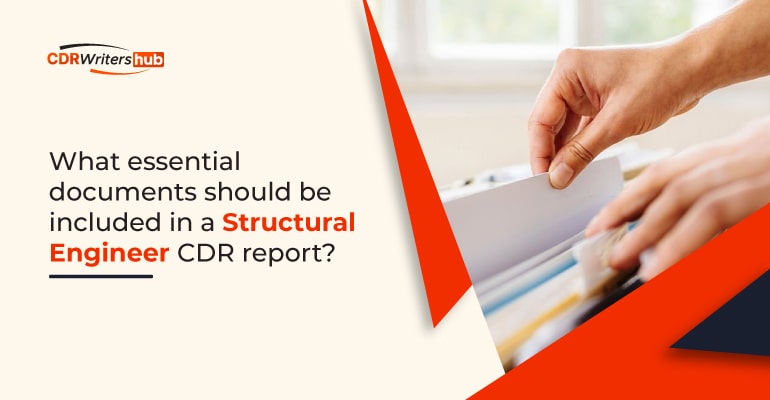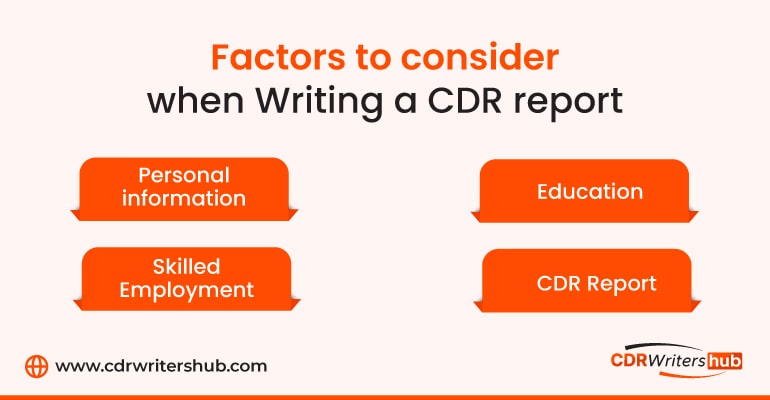Essential documents to include in a Structural Engineer CDR report

Essential documents to include in a Structural Engineer CDR report
Structural Engineering falls under the domain of Civil Engineering. A structural engineer drafts drawings and specifications, performs calculations, reviews other engineers’ work, writes reports and evaluations, and observes construction sites. To practice structural engineering, a professional engineering license is required. The role of structural engineers is to ensure that the structures we use daily, such as bridges and tall buildings, are safe and stable and don’t collapse when loaded. Based on their technical understanding, they specify diverse aspects of the construction materials that can endure the pressures and strains of the environment, such as gravity loads, storms, and earthquakes.
In the case of a Structural Engineer CDR report, we have highlighted the role of the Structural Engineer and some essential documents.
Role of Structural Engineers
Table of Contents
Structural engineers play a major role in the construction process. Buildings, bridges, and monuments are structures for which structural engineering is concerned within the broader civil engineering discipline. Structural engineers must have a decent knowledge of mathematics and the ability to apply those skills to solve issues efficiently. On the other hand, understanding the fundamental ideas of mechanics, mathematics, and physics is insufficient to qualify someone as an engineer. These skills must be cultivated by employing them to build safe and long-lasting constructions. Structural engineers usually take a complex concept design into a practical, secure, and cost-effective solution.
- Examining designs, maps, statistics, and topographic and geological information
- Estimating material, equipment, and labor costs and quantities;
- Design specifications are determined by calculating load and grade requirements, water flow rates, and material stress factors.
- Inspecting construction sites to track progress and confirm that the project is being built according to plan;
- Conducting traffic or environmental studies to detect potential issues and determine how they may affect the project.
Task of Structural Engineering
- Deciding on building methods, materials, and quality standards and creating and interpreting specifications, drawings, plans, and construction methods and processes.
- Soil and rock samples are collected at various depths throughout sites and tested to determine strength, compressibility, and other qualities that affect soil and rock behavior when a structure is imposed and estimate the safe loading for the soil.
- Developing detailed cost plans and estimates as budgeting tools by evaluating architectural and technical drawings and specifications.
- Keeping track of design changes measuring, valuing, and negotiating design variants.
- Static and dynamic loads are analyzed in structural systems.
- Ensuring that structures do not collapse, bend, twist, or vibrate in an unfavorable manner.
- Evaluating current and future transport flows considering the changing requirements of the population.
- Highways, railroads, urban transit, air transportation, logistical supply systems, and their terminals are all physical features of transportation systems.
Introduction to Structural Engineer CDR Report
CDR is a process that Structural Engineers – ANZSCO 233214 must go through if they want to come to Australia permanently. If an international student’s qualification is not recognized by the Sydney, Dublin, or Washington Accords, a CDR report is required for the visa application. Engineers Australia is in charge of this competency evaluation. When it comes to evaluating talents, Engineers Australia is very strict. Applicants must follow the migration skill assessment (MSA) handbook to be accepted.
Engineers Australia requires Structural Engineers to demonstrate competence by writing a CDR that meets all the necessary criteria. Unfortunately, applicants with no experience in this field may be rejected because they lack an understanding of the CDR report before consulting an expert. While you may argue that employing a professional to write a CDR report is unnecessary, keep in mind that they are commonly rejected due to minor flaws.
Necessary documentation for CDR report for a Structural Engineer
If you believe that submitting the CDR Report is the only thing you need to do, you are mistaken. In addition to the visa processing, further documents must be given to Australian immigration authorities before handing them over to them. A basic CDR must include the following documents:
- CDR application, self-signed by the engineer, disclosing the engineer’s real thoughts.
- Academic records from high school to college.
- Curriculum vitae
- An engineer must also provide immigration agents with a Continuing Professional Development (CPD) document to demonstrate the value and efficiency of their profession.
- If you’re a structural engineer from a nation where English isn’t the first language, you must prove your language skills. You strongly recommend submitting your CDR with an IELTS/PTE certificate.
- Three Career Episode Reports
- Summary Statement with your CDR
Factors to consider when writing a CDR report.
1. Personal information
The following items make up your personal information:
- (35mm*45mm) photo for a passport
- Primary identifying information, such as your passport name change paperwork’s page (e.g., marriage certificate)
- Curriculum Vitae (CV)
- English language proficiency test
2. Education
You must submit your educational qualifications, transcripts, and other supporting certificates. You must list your engineering credentials in a proper format. You will need an enrollment letter and, if possible, transcripts if you are enrolled in the course of study.
3. Skilled Employment
Candidates must have a lot of experience in their field. Candidates whose professional engineering knowledge is the foundation of their career episode must provide a letter of recommendation from their current or previous employer. On the other hand, applicants who want a suitable employment appraisal must offer both primary and secondary document verification.
4. CDR Report
A CDR report combines a well-written Curriculum Vitae, Continuing Professional Development, three Career Episodes, and a Summary Statement.
i) Curriculum Vitae (CV)
Your CV should be well organized to stand out in a crowd. A resume will be impressive if it contains a good combination of educational background, career experience, triumphs, aspirations, and qualifications. Experienced professionals should document everything chronologically. The most recent work experience should appear first in your CV, followed by your previous ones. Your most recent employment experience and any initiatives you were involved in should be highlighted.
ii) Continuous Professional Development(CPD)
CPD is a set of principles, ideas, and tactics for advancing your career. CPD Statements are defined as something that assists you in broadening your knowledge, staying current on new approaches, and growing your engineering career. The CPD Statement emphasizes the importance of outcomes or the advantages that professional learning can provide in the actual world. Participating in CPD Statement activities can also help you expand your professional networks and contacts. Regardless of where you are in your job or the goals you’ve set for yourself.
iii) Career Episodes
The career episodes should highlight the duties and objectives of your project and depict the one-of-a-kind period of your engineering career. Every aspect of your career episode illustrates your expertise and abilities in your chosen industry. Plagiarized content will be rejected; thus, the applicant should write their report based on your own experiences. Career episode has sections as follows:
- A brief introduction includes the date, length of employment, location, and organization’s name.
- The background includes your engineering activity, project goals, work area’s characteristics, a chart of your organization’s structure and location, and duties.
- The engineer activities describe what you have accomplished and how you did it. Additionally, you may incorporate technology, tactics, and teamwork issues.
- The summary section sums up all of your project’s activities.
iv) Summary Statements
You’ll need to write a summary statement after you’ve finished all three areas of your results. A summary statement is a synopsis of all aspects of your knowledge. As a result, you must thoroughly examine your professional experience in this subject to ensure that you have covered all bases. It must be well-thought-out, connecting all of the dots in your professional life. Because only one summary statement is necessary for each of the three career episodes, you should not limit your summary statement to one page. Your Competency Element should include the following items while composing your summary statement.
- Skill and Knowledge Capabilities
- Expertise in Engineering Applications
- Personal and professional qualities
CDRWritersHub for your assistance.
CDRWritersHub provides you with the opportunity to write your report with the assistance of our professional writers. Keep the EA criteria in mind and follow each piece of advice to ensure that your evaluation is completed correctly. Our team can help you with CDR reports, RPL reports, plagiarism detection and removal, EA feedback services, and other reports if needed.




